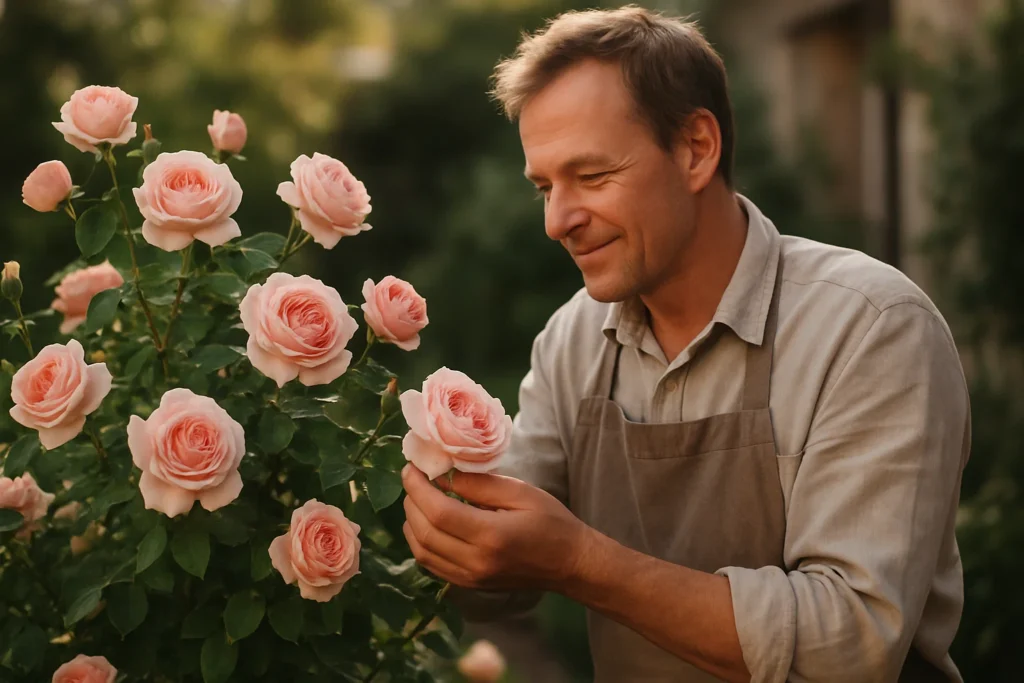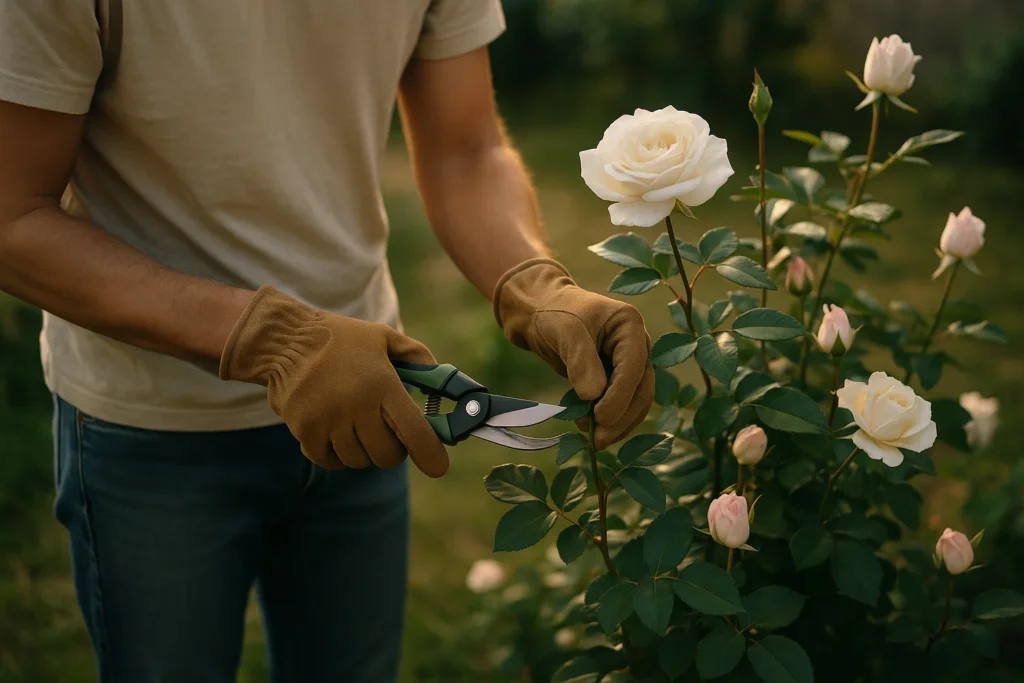Roses are probably one of the most popular flowers in the world, which are valued because of their beautiful flowers and pleasant smell. You may have a standard red rose bush or you may like the dainty wild rose flowers, but with the knowledge of how to correctly take care of your roses you will be able to enjoy their beauty year after year. In this guide, you’ll discover everything you need to know about rose plant care from planting rose plants in pots or garden beds, understanding rose sunlight needed, to rose bush maintenance and pest control.
Why Growing Roses Is Worth the Effort
The landscaping or garden is incomplete without roses. The diversity of the roses is to have numerous types of plants satisfying growth habits, color, aroma, and size. This makes it suitable in flower beds, as a hedge plant or contained planting.
The simple steps in caring about rose plants may be the ones that determine whether the bushy rose plants or have shy shrubs with fewer flowers. Roses are robust but need some care and nutrients when provided with the right conditions.

Wild Roses vs Cultivated Roses: Key Differences
Wild Roses: The wild roses are naturally enhanced in the most crude form and the flowers are simple and typically have five petals. They are tough, versatile and bear blossom once a year, therefore ideal in natural gardens and in preventing erosion.
Cultivated Roses: Garden roses are achieved through breeding roses to be more colorful, bigger and frequently fragrant with multiple-layered petals. They are more demanding, i.e., they need to be pruned and fertilized more often. They can flower again and again during the spring, summer and fall seasons, lasting longer.
| Feature | Wild Roses | Cultivated Roses |
| Growth Origin | Grow naturally without human intervention | Selectively bred by humans over decades/centuries |
| Flower Structure | Simple, often 5 single petals | Complex, layered petals |
| Color Range | Limited, usually shades of pink, white | Wide range: pure white, pink, red, crimson, and more |
| Bloom Frequency | Usually bloom once a year | Can bloom repeatedly from spring to fall |
| Toughness and Care | Very tough, adaptable, minimal care needed | More delicate, require pruning, fertilizing, and disease control |
| Uses | Naturalized gardens, erosion control | Formal gardens, landscapes, cut flowers |
| Fragrance | Generally mild or light | Often intensely fragrant varieties available |
How to Plant Rose Plants: Starting Right
Carefully planting rose plants sets the stage for good growth and lovely flowers. Selecting a suitable site, soil preparation, as well as placement of plants are very important initial steps. A proper start will give your roses a good foundation to root, overpower diseases, and thrive well during the growth period.
Step 1: Selecting a Proper Place
Roses flourish in areas, that are fully exposed to sunlight, a minimum of 6 hours of direct sunshine per day. All varieties can survive partial shade, although the more sun the better the bloom, the healthier the plants.
Considering your use of garden or rose landscape, choose a place with high air circulation to minimize fungal diseases. Avoid those low, damp areas where water could accumulate.
Step 2: Soil Preparation
Roses like light and porous soil of loamy texture with a wide amount of organic matter. Compost or well-rotted manure should also be dug into the ground before planting to increase moisture and fertility. The soil pH is preferably slightly acidic to neutral (6.0- 7.0).
Step 3: Planting Rose Bushes
When planting rose bushes whether in pots or in garden beds, dig a hole twice the diameter of the root ball and twice the depth. Pot-bound roots should be loosened gently, the bush inserted and the soil backfilled. Plant deeply and water well.
When you are planting bare-root roses, submerge them in a container of water some hours before planting and then cover the graft union with the soil approximately 1-2 inches below the ground.
How to Care for Rose Bushes: Daily and Seasonal Tips

Rose bushes need regular care all year round. Roses require daily care, seasonal care such as watering, feeding, pruning and also controlling the pests to ensure healthy roses that are also productive. These basic care measures make your roses healthy and bloom season after season.
Roses require steady moisture particularly during the growing and blossoming period. Water once or twice a week deeply according to rainfall and temperature. Wetting of the leaves should be avoided to avoid fungal issues.
Watering Your Roses
Roses require steady moisture particularly during the growing and blossoming period. Water once or twice a week deeply according to rainfall and temperature. Wetting of the leaves should be avoided to avoid fungal issues.
In the case of potted roses, you should check the soil moisture regularly because containers dry fast. Mulch to keep moisture.
Fertilizing Roses
Fertilize your roses to make them grow robustly and produce many flowers. Blooms need a balanced rose fertilizer or a high phosphorus, potassium fertilizer.
Typically, fertilize:
- Mid-spring, when new growth begins
- Once the initial cycle of bloom is over
- Late summer, however, not too late to prepare roses to go dormant during winter
Compost teas, fish emulsion, or bone meal are organic alternatives.
Pruning Rose Bushes
Pruning keeps shrubs in their size and shape, eliminates dead or diseased wood, and promotes new growth. Pruning is most effective in late winter or at the beginning of spring when new buds of leaves open.
Prune off a third of the height of the plant by cleanly snipping above outward facing buds. Cut off weak or crossed branches.
Pests and Diseases on Rose Bush
Aphids, spider mites, black spot, powdery mildew and rust are common problems.
- Examine roses occasionally to check for the pests.
- Apply insecticidal soaps or neem oil when there is a small infestation.
- Make sure that there is air circulation as well as water at the bottom to minimize fungal diseases.
- In severe cases, use right fungicides or seek advice from local gardening shops.
Rose sunlight needed
The majority of the roses require 6-8 hours of sunlight per day to flower well and grow. Insufficient sun may bring about:
- Less flowers
- Weak bushes with long legs
- Greater susceptibility to disease
Partial shade is tolerated by some shrub and landscape rose varieties, but they exhibit less bloom production. When you have more shady areas, then you should consider plants that grow well in the shade, and then use the roses in areas that have more sunlight.
How to Care for Roses Planted in Containers

Container roses can grow and flower magnificently. However, their roots are restricted and thus require a bit of extra care and attention. This is how to keep roses that are planted in pots healthy and blooming throughout the season.
1. Select Good Container and Soil
Select a pot that will allow the root ball of the rose to fit comfortably with room to expand; in most instances, the size of the pot should be no less than 12 to 18 inches deep and wide. Larger pots retain moisture and keep roots cool, but they are heavy or locating pots where they will not need frequent movement helps.
Ensure that your pot allows proper drainage so that it does not have stagnant water that may lead to root rot. Put a good quality, well-draining container potting mix, which is suitable for working in containers and not garden soil, which is dense and can smother roots. Fertility and drainage are enhanced by adding some compost and perlite.
2. Exposure to Much Sunlight
Roses are sun lovers- place your container in such a position that receives at least six hours of direct sunlight each day. Sun in the morning is best since it evaporates dew, which prevents disease. Roots can overheat, so in a very hot climate, some afternoon shade or a light-colored pot can help.
3. Deeply and Often Water
Containers also dry out faster than garden beds, and should have their moisture levels monitored. When the top one inch of soil becomes dry, water your rose. Have a good drink, until water comes out of the bottom drainage holes, and the root zone is wet. Every day in hot weather may be needed, but in cooler months, the frequency of watering can be lessened–yet never allow the soil to become dry.
4. Your Roses should be Frequently Fed
Container roses should be fed regularly because nutrients can be leached out by regular watering. A slow-release rose fertilizer ought to be mixed in at the time of planting. Thereafter, use a balanced liquid fertilizer 4 to 6 times during the growing season to keep the plant with plenty of blooms and good foliage. Compost tea or fish emulsion are organic alternatives that are great as well.
5. Deadhead and Prune Often
Maintain your container rose in good condition and in flower by cutting off weak or dead stems and deadheading (cutting off old flowers). This activates new growth and prolongs flowering. Pruning should be done with sharp and clean pruning shears and lightly during the season, with a heavier prune in early spring or when the main blooms are over.
Rose Landscape Uses
Use Roses in your landscape to provide beautiful focal areas, hedges or combined flower beds. The grouping of rose varieties with different heights and textures will lead to a variety.
Plant companion plants to keep away pests, such as lavender or catmint, to match rose flowers.
Conclusion
Rose care need not be a challenge. With the right amount of sunlight, proper watering, feeding with good fertilizer and pruning roses regularly, you can have wonderful and healthy roses all year round.
Many seeds need good soil, a lot of sunlight and careful observation of how your plants are doing, so that you can adapt your care to their needs. By being patient and keen, your rose bushes will give you beautiful flowers, which will light up your home and garden. These few easy steps will ensure that you cultivate beautiful roses and a garden that you may be proud of.
FAQs
Yep, 6 or more hours of direct sunlight are ideal in making most roses grow healthy and flower lots.
Water deeply 1 to 2 times a week depending on conditions. Prevent the wetting of leaves to lessen the disease.
Pruning should be done during late winter or early spring when new leaves are still not growing.
Absolutely! Pick large containers, good potting soil and water/fertilize frequently.
Keep good circulation of air, water at the bottom; infected leaves should be removed and fungicides where required.



